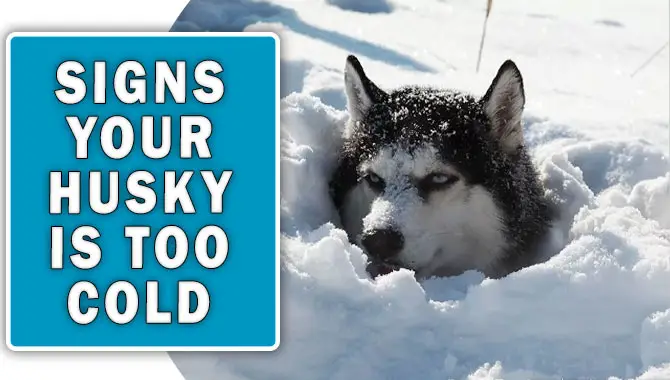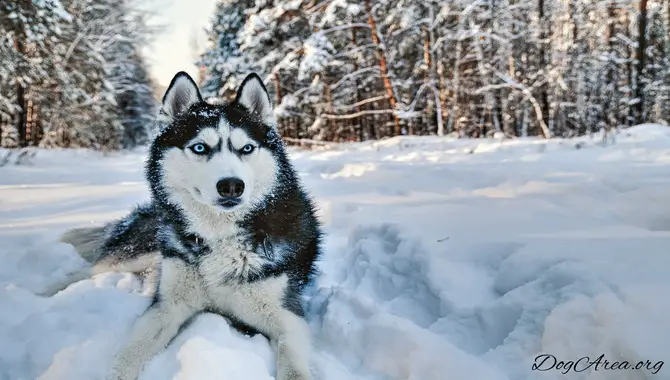The Siberian husky breed originated in Siberia. This breed is popular for its ability to tolerate cold weather. These dogs were used to pull carts along the icy Siberian tundra.
As with any breed, certain signs indicate if your dog is too cold. While these signs may not be visible to the naked eye, you should always consider them. If you notice your pet shivering, whining, pawing at its face, or sleeping excessively, it’s best to take action to keep them warm and safe from frostbite. Read more on this Breeds Signs Your Husky Is Too Cold Hub blog here.

8 Signs Your Husky Is Too Cold

Husky dogs are well-known for their high energy level and love of cold weather. However, it’s important to understand the signs of hypothermia in huskies and take action if you notice them. Here are some common signs of hypothermia in huskies:
1.Weather.
Huskies can feel cold if the temperature drops below 10°F (–12°C). They will begin to shiver and may become lethargic. If the temperature continues to drop, huskies may be reluctant to move and appear lethargic. When it is cold for humans, it is cold for huskies. However, it is important to note that some dogs can tolerate colder temperatures. If the weather conditions persist, bringing your husky inside or to a warmer location is best.
2.Shivering.
Shivering is a common symptom of cold in dogs. These sing is a reflexive response to cold temperatures in which the body generates heat by rapidly contracting muscles and releasing heat-generating internal chemical byproducts. In dogs, shivering often takes the form of up-and-down body movements, particularly of the tail. Dogs experiencing mild hypothermia may have a body temperature of 90-99°F.
When temperatures reach 45°F or below, dogs should not be outside for long periods. Instead, you should shelter them indoors with access to a heater. Below 32°F, most dogs will start feeling uncomfortable and begin displaying other signs of cold stress, such as poor coat condition and increased panting.
3.Cold Ears.
Cold ears are a sign that your husky may be too cold. Dogs typically display cold ears when their body temperature drops below the normal range. If the husky’s ears feel cold to the touch, it is likely too cold for the dog. Signs that your husky is too cold may include shivering, barking, and whining. If you notice any of these signs, it is best to immediately bring the dog into a warmer area.
4.Slow Movements.
Dogs shiver in cold temperatures to maintain body heat. When shivering stops, the body loses heat faster, and hypothermia can occur. Dogs may shiver, whine, have difficulty walking, or even fall over due to cold temperatures. Hypothermia is life-threatening, and you must monitor dogs for signs of being uncomfortably cold when temperatures drop. Once inside, you should monitor dogs to make sure they are okay. If a dog is indoors for long periods during cold weather, they need access to warm bedding and shelter from the cold wind.
5.Curling Up.
Huskies are popular for their thick fur coat, but that doesn’t mean they can’t get cold. When you notice your husky curling up and staying inside for long periods, it’s a sign that it’s too cold outside. Other signs that your husky may be too cold include panting, shivering, and reluctance to move. If you notice these signs in your husky, take him to the veterinarian or a dog professional as soon as possible. This will help ensure your pet stays warm and healthy throughout winter.
6.Limping.
It may be too cold for him if you notice any of the signs listed above in your husky. If your husky is limping, it is likely cold and may require help warming up. Additionally, huskies are susceptible to frostbite in their paws and toes when the temperature drops below 50 degrees Fahrenheit.
If you notice these signs in your husky, immediately take him to a veterinarian. In extremely cold weather, avoiding physical activity with your dog is best to protect him from frostbite. Instead, keep him warm and sheltered indoors or in a warm shelter. Besides, ensure he gets enough food and water to stay hydrated and healthy.
7.Whining.
Whining may be a sign of a dog being too cold. Dogs may whine when they are cold or uncomfortable, and whining can be an indicator of pain or distress. Other signs of a dog being too cold include shivering, reluctance to walk, lifting paws frequently, and falling over.
If your dog is whining and shivering uncontrollably or appears anxious and unwilling to move, bring it inside as soon as possible to protect its body heat. If it’s too cold for an owner to stand outside without a coat, it’s probably too cold for the dog. Your pet needs proper shelter and cares to survive the cold weather safely.
8.Extreme Sleepiness/Lethargy.
Lethargy and extreme sleepiness can indicate that a dog is too cold. Lethargy in dogs is common during cold weather as they seek warmth. However, lethargy can also occur due to other factors, such as hypothermia or poisoning. If you notice your dog exhibiting lethargy, immediately take them to the vet. Additionally, dogs may curl up for warmth and become increasingly sluggish as hypothermia occurs.
Which Breeds Feel The Cold The Most?
Many dog breeds are more adapted to cold weather than others. Some dogs that can survive in cold weather include Alaskan huskies, Samoyeds, Yorkshire terriers, Pomeranians, and Maltese and Chihuahuas. These dogs have thicker coats and fur to protect them from the cold.
Puppies and geriatric patients will have more difficulty regulating their body temperatures in cold weather. Health conditions like heart disease, kidney disease and diabetes can make dogs more susceptible to the cold. Common breeds that feel cold easily include Pomeranians, Boston terriers, French Bulldogs, German shorthaired pointers, Jack Russells and Great Danes.
These dogs are popular for their warm coats and floppy ears that allow them to retain heat. They also tend to be energetic and playful in the winter. Avoid leaving your dog outside in cold weather unless it is designed for that climate. Also, keep your dog indoors during the winter months.
Physical Size
As smaller dogs have a smaller heat-generating capacity and a shorter coat, they are often more adversely affected by cold temperatures. Dogs with thin coats and small body mass, such as Chihuahuas, Pugs, and Jack Russells, can easily overheat in warm weather and become hypothermic. Conversely, larger dogs with thick fur and greater body mass, like Anatolian Shepherds and Siberian Huskies, can stay warm even when cold.
Large breeds have thicker coats and higher muscle mass, which help them to resist cold temperatures. Puppies and geriatric patients have more difficulty regulating their body temperature in hot and cold climates. Health conditions like heart disease, kidney disease, or diabetes can make dogs more susceptible to the cold.
Type Of Coat
Huskies have a “double-layered” coat with an undercoat and a coarser topcoat of guard hairs. The undercoat comprises small-length hairs, which form a dense layer of insulation to keep the husky warm. The topcoat is a protective layer, shedding the excess hair that can cause heat loss.
This coat type helps huskies retain their body heat in cold weather. In addition, some large thick-haired dog breeds, such as Alaskan Malamutes, Newfoundlands, Samoyeds, and Siberian Huskies, are well-suited for cold climates due to their coat type and fur length.
History Of The Breed
Siberian Huskies are native to the cold regions of Siberia and have a long history of being bred in cold climates. These dogs were historically used for their ability to flourish in cold weather and work as sled dogs. Their thick fur and large bodies help them stay warm during these cold temperatures. Siberian Huskies are well-known for their playful and energetic personalities and make great family dogs. They are popular for being affectionate, friendly, and protective dogs who enjoy spending time with their owners.
Siberian Huskies can now be found worldwide, even in hot climates. These dogs are adaptable and can thrive in various weather conditions, making them an ideal choice for those who live in cold climates or want a dog that will not be overwhelmed by the heat.
Conclusion
Siberian Huskies are ideal for those who live in cold climates or want a dog that will not be overwhelmed by the heat. These dogs can tolerate temperatures as low as -51°C (60°F), and some can even tolerate temperatures lower than -30°C [-22°F], depending on the environment in which they are born and raised. Most huskies will appreciate a blanket or dog sweater at night, depending on the thermostat setting in the house.
Now that you’re well-informed of the signs that your husky is cold or cold-sensitive, you can tell if they’re faking it. While it’s natural for huskies to shiver, whine, and be stiff while cold, it’s also normal for them to feel sleepy when it gets cold. Take your huskies indoors if the weather forecast mentions frost or snowfall. It might be time for a warm bed and some extra snuggles.
Frequently Asked Questions
[rank_math_rich_snippet id=”s-1d608393-ea47-465f-bdc1-5baabe6787fc”]